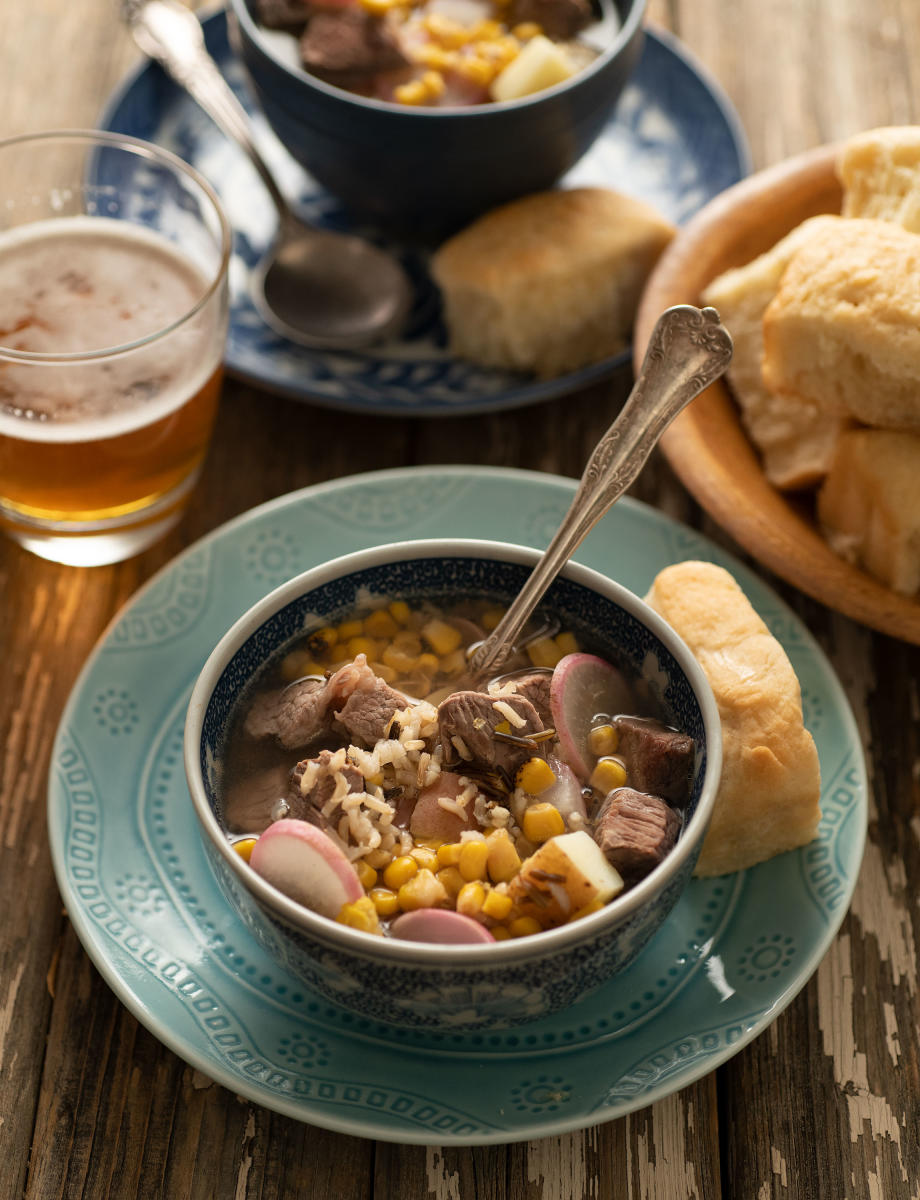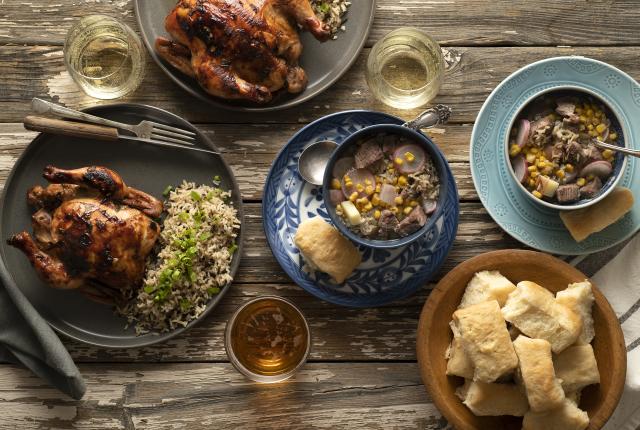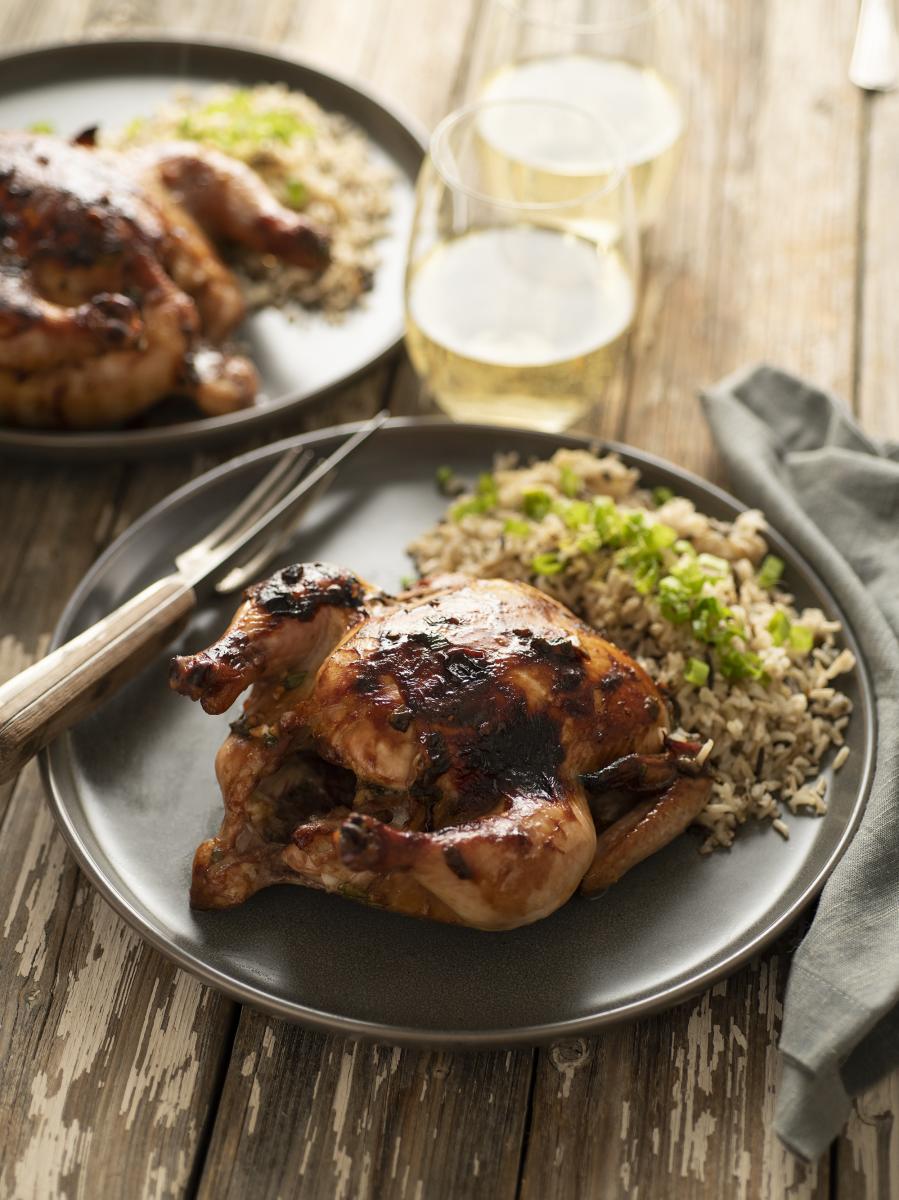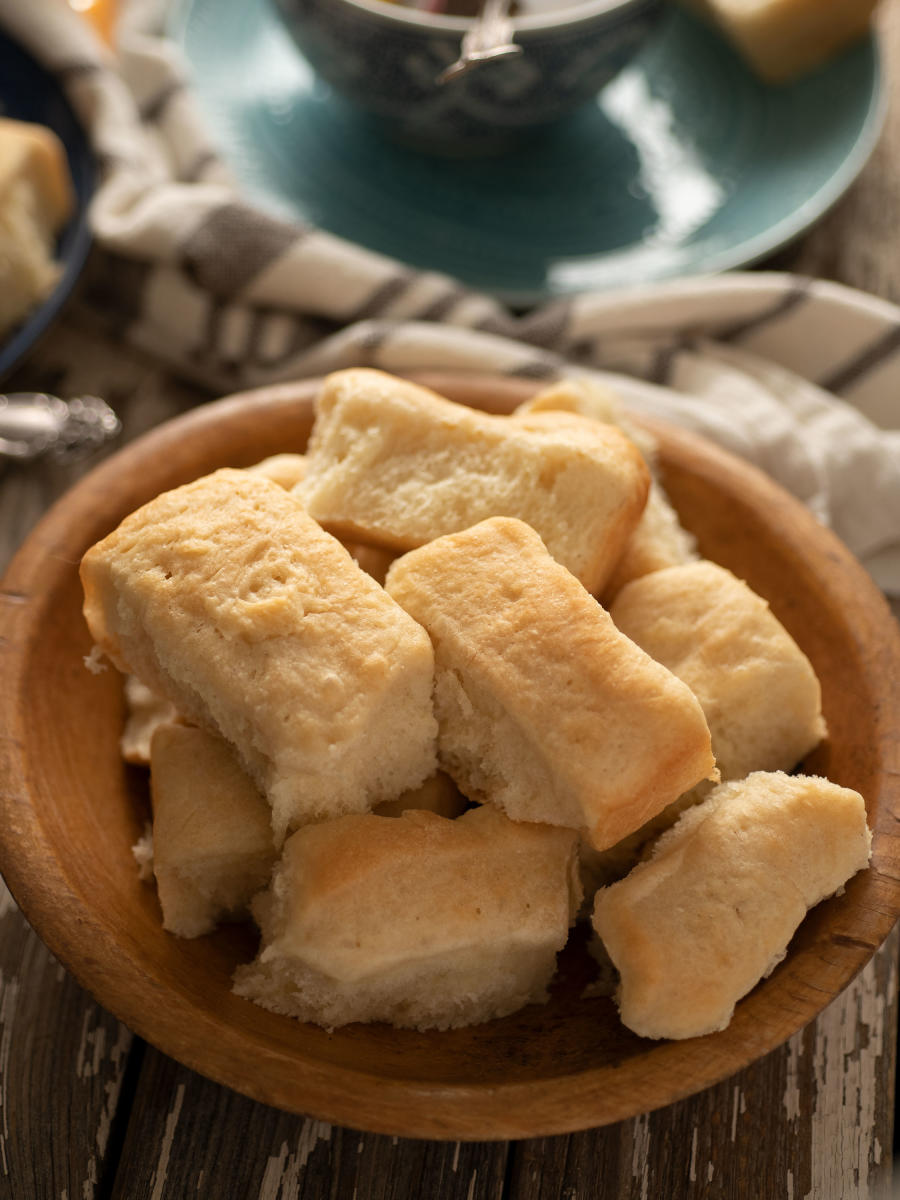A New Mexican Thanksgiving feast.
NEW MEXICO'S MELTING POT of cultures delightfully graces our holiday dining tables. I can attest: The first time the plain pan gravy of my youth was replaced by red chile “gravy” at a Santa Fe feast, this East Coast boy knew he’d found his new home.
I was thrilled that the standard green bean casserole was overshadowed by calabacitas fired up with green chile. And who would have guessed that pecan pie could be even more delicious with piñon nuts?
Most of the Thanksgiving dinners I’ve been invited to have been the work of many hands—an outcome that may be hard to emulate this year. Many of us can’t gather in large family groups. Some may carve the turkey (or, this year, a smaller bird) virtually with friends and family. But the twin goals of Thanksgiving—speaking our gratitude and sharing the bounty—seem more important than ever.
This month, I asked three notable New Mexicans to share their memories, recipes, and reasons to give thanks. As for me? I’m grateful for the resilience of our restaurant chefs and staff who have weathered this year’s tumultuous storm. We are all blessed that customer support and a deep desire to feed us has kept them inspired. More than ever, food is love. (And you’ve just got to try my recipe for a dried-apple-and-pecan pie.)
PATRICIA MICHAELS
A Taos Pueblo native and nationally recognized clothing designer. In 2012, she was the first Native designer to compete on the Project Runway TV show and Project Runway All Stars, two years later. Her clothing company, PM Waterlily, offers high-end, limited-edition apparel as well as casual lines for men and women.
MEMORY: “My grandparents would joke, ‘Cheers to the Pilgrims’ as we lifted a cup of grape soda at the beginning of the dinner. All the women in our family, from my grandmother down to me, because I was the youngest, helped in the cooking. We would get water from the river to cook and clean with. There would be eight of us inside and upstairs in a small pueblo kitchen with no electricity or running water, only a kerosene lamp and woodburning stove. The men would stock the woodpile a couple times the day before and all during the day of cooking. It was fun and full
of laughter.
“Depending on the abundance of the harvest, our dinner might include things like fried venison, wild plum pie, wild mushrooms, buffalo stew with wild celery, wild rice, and other vegetables, including our own corn, squash, chicos, posole, and sometimes Indian tea. And, of course, we always had a pot of Grandma’s delicious red chile.”
GRATEFUL FOR: “I planted my first garden this year; now I have my own harvest to add to the feast. I have a happy, healthy garden, and I have loved the feeling of Mother Earth’s wet soil beneath my feet while all her gifts of food dance in the water and the sunshine. There is nothing like being in nature.”

Taos Pueblo Buffalo Stew
Serves approximately 22 people
The directions for this traditional stew are somewhat free-form. “Depending on the abundance of the harvest,” says Patricia Michaels, “it might include wild celery, wild rice, and other vegetables, including our own corn and squash.” (Michaels’s brother-in-law provides dried wild turnips from North Dakota.) Feel free to improvise with your own favorite vegetables in the amounts you choose.
7 pounds buffalo meat
1 pound wild rice
Vegetables (Michaels suggests corn, wild celery, and turnips; sweet potato or butternut squash, celery, and onions are also a nice combination)
Salt and herbs (oregano, marjoram, and basil are always nice), to taste
-
Cut buffalo meat into good-size cubes, not too huge but not too small.
-
Place in a large pot and cover with cold water. Add 2 tablespoons salt, or to taste.
-
Bring to a rolling boil and cook for 30 minutes and then reduce the heat to low. Simmer for 1 hour.
-
Add wild rice and continue simmering for another 3 hours or until the meat is tender.
-
During the cooking, add vegetables depending on the harvest and what is available.
-
Add salt and herbs to taste.
KEN MIYAGISHIMA
Mayor of Las Cruces since 2007. The Biloxi, Mississippi, native is a child of Mexican and Japanese parents. He has lived in New Mexico since 1971 and is a 1985 graduate of New Mexico State University.
MEMORY: “On occasion, my dad would make sushi while my mom prepared enchiladas for Thanksgiving. We always had red chile, pork, and tortillas. My favorite holiday dessert is pumpkin pie with ice cream.”
GRATEFUL FOR: “I’m thankful that we have hardworking, caring public safety professionals who risk their lives daily serving and protecting the residents of Las Cruces. I’m also thankful for the public educators who risk their lives teaching our children and adults at our schools and colleges.”
Teriyaki-Glazed Cornish Game Hens
Serves 2–4*
The mayor serves this sauce (he just eyeballs the ingredients) with turkey, but I was inspired by his idea, so I prepared this recipe to give a unique flavor to Cornish game hens for smaller gatherings.
2 Cornish game hens (about 1½ pounds each)
1 10-ounce bottle soy sauce
2 tablespoons sake or mirin
1 teaspoon salt
¼ cup brown sugar
¼ cup thinly sliced scallions
1½ teaspoons minced garlic
1½ teaspoons minced fresh gingerroot
½ tablespoon cornstarch
1 tablespoon cold water
-
In a medium bowl combine soy sauce, sake or mirin, salt, and brown sugar. Whisk together until sugar has dissolved. Stir in scallions, minced garlic, and ginger.
-
Rinse and dry hens. Place in a large plastic storage bag and pour marinade over. Allow to marinate for at least one hour and up to two hours in the refrigerator.
-
Preheat oven to 400°. Place roasting rack on a large rimmed baking sheet. Arrange hens on rack; baste with marinade from bag. Roast hens until cooked through and brown, basting occasionally with the sauce (see below), about 1 hour. Cook until internal temperature reaches 165° and the juices run clear.
-
Once the hens are in the oven, strain the marinade and heat in a small pan. Mix water with cornstarch to a thick paste consistency. Pour in cornstarch mixture and immediately whisk teriyaki sauce until it begins to boil and thicken. Once thick, remove a cup of sauce to baste the hens.
-
To make the hens easier to eat, cut in half down the breast and remove rib bones from the underside. Serve with rice seasoned with more chopped scallions and fresh grated ginger.
*Depending on the size of the Cornish game hens, sometimes only a half is needed per guest. If they are on the smaller side, serve each guest a
full hen.
LILLIAN MONTOYA
President and CEO of Christus St. Vincent Regional Medical Center, in Santa Fe. Growing up in Albuquerque as part of a large family, Montoya learned the value of teamwork, something that helped her hospital team brave the pandemic this year. Three decades ago, she and her young family settled in Eldorado, near Santa Fe, where she set out to “adopt” neighbors into helping her make holiday treats.
MEMORY: “The grandmothers and the moms in my large extended family did all the cooking, but we kids pitched in with the tamales and the bizcochitos. We would start days in advance, forming a family assembly line for the tamale rolling and the cookie baking. There were always red and green chile sauces on the table.”
GRATEFUL FOR: “I am constantly inspired by my team at the hospital, with their commitment to the community. It’s what gets me out of bed in the morning. I am also blessed with two amazing kids who each, in their own way, are helping make the world a better place.”
Quickie Dinner Rolls
Makes approximately 2 dozen
Lillian Montoya says she’s grateful that her former mother-in-law taught her how to make a prune pie with plums from their trees in Questa. “And to this day, I still make her dinner roll recipe, which isn’t just for the holiday!”
1½ cups warm water
1 package yeast (2¼ teaspoons)
1 stick unsalted butter, melted*
¼ cup sugar
1 egg, beaten
4 cups all-purpose flour
1 teaspoon salt
-
In a small bowl, dissolve yeast and sugar in warm water; allow to sit for 10 minutes.
-
In a large bowl, mix together all ingredients, adding additional flour as needed, and knead to form a smooth dough. Cover and allow to rise in a warm place for one hour or until dough has doubled in size.
-
Punch down dough and form individual rolls that are 2 inches square and 1 inch thick. Place the rolls touching each other on a jelly roll pan and bake at 375° for 18–22 minutes or until lightly browned. If the rolls are getting too brown, tent them with foil.
-
Separate the rolls and serve immediately or store cooled rolls in a plastic bag for up to 3 days.
* Montoya says that the original recipe called for margarine, but she likes butter better.
Johnny Vee's Brown Sugar, Dried Apple, and Pecan Pie
Makes 1 pie
I like this recipe because you do not need the light and dark corn syrups called for in traditional pecan pies.
2 ounces dried red delicious apples (about 1½ cups), from Montoya Orchard, in Velarde
1½ cups apple cider
1 9-inch piecrust, from a box or homemade
1 cup brown sugar, packed
¼ cup granulated sugar
½ cup unsalted butter, melted
2 large eggs
¼ teaspoon salt
1 tablespoon all-purpose flour
1 tablespoon milk
1 teaspoon vanilla
1 cup CLC pecans, from Hobbs
-
Preheat oven to 400°.
-
Place apples in small saucepan and cover with cider. Simmer over medium heat until apples soften and cider is starting to look like maple syrup, about 12 minutes. Drain apples and set aside. Reserve syrup.
-
Place piecrust in pie pan and crimp edges as desired. Chill until ready to fill.
-
Whisk together both sugars, melted butter, eggs, salt, flour, milk, and vanilla until smooth. Stir in pecans and apples and pour into prepared crust.
-
Cover edges of piecrust with foil or a piecrust shield. Bake for 10 minutes, then reduce the heat to 350°. Bake an additional 30–40 minutes, or until the middle and the edges are set. Remove foil for the last 10 minutes of baking. Pour reserved syrup over the surface. Cool pie completely before slicing.





